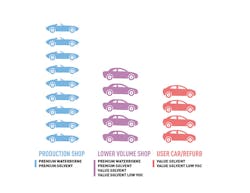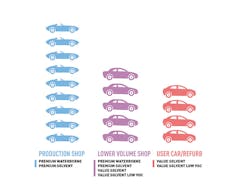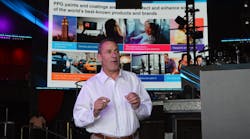Editor's note: This article was originally published Dec. 4, 2019. Some of the information may no longer be relevant, so please use it at your discretion.
Competitive pressures are forcing collision centers to make repairs faster and more efficiently, without sacrificing quality. Add to that the introduction of more sophisticated OEM colors and refinish systems have to keep up—including meeting environmental legislation. But which one is right for your collision shop? That depends on a variety of factors including your spray booth, equipment and the type of business you operate. Let’s take a closer look.
The production shop
If your collision center outputs more than 10 cars per week, has DRP business, and monitors cycle time performance as part of your lean collision practices, a premium-quality refinish system capable of excellent color-matching and high production throughput is a must. This also applies if your business has OEM certifications or repairs luxury vehicles.
In National Rule regions (not governed by stricter VOC compliance regulations), production shops have a choice of premium refinish technology to consider: a waterborne or solvent based system.
The waterborne option
If you seek out the state-of-the art in refinish technology, there are many reasons to like waterborne basecoat. First, if you consider yourself environmentally progressive, making the move to waterborne basecoat can minimize paint odors and create a healthier workplace for your employees, without sacrificing performance. Thousands of high-production collision centers located in National Rule areas have moved to a waterborne system—often citing its color matching excellence and process performance in addition to the environmental benefits.
Waterborne basecoat can provide extremely consistent color mixing by taking advantage of anti-settle toners. PPG’s waterborne toners, for instance, require no mechanical mixing, so there’s little chance of under or over-agitating or grinding down of metallic colors. Even small amounts of toner yield consistently accurate matches.
Given that the majority of factory finishes utilize waterborne technology, waterborne basecoat for refinish is well suited for matching the ever-increasing number of translucent, highly chromatic colors offered by the OEMs. Painters can achieve excellent metallic control because latex toners can correctly orient the metallic flakes and provide the appropriate color travel from face to flop. Waterborne users also point out the ability to perform easy, “invisible” blend repairs with no halos or blotchiness.
In terms of cycle time performance, waterborne basecoat systems are more than capable of meeting or exceeding the throughput demands of the high-volume collision center as evidenced by their popularity with MSO enterprises.
The prerequisites for implementing a waterborne system must be considered when deciding whether or not to make the switch. Attention must be paid to your paint booth’s ability to deliver proper air movement and ample clean, dry air. That’s because airflow, temperature and humidity play roles in the basecoat’s evaporation rates. In essence, the basecoat dries from the bottom of the film up. Therefore, creating good airflow across the wet waterborne basecoat can significantly improve flash times and dramatically improve cycle time productivity.
If you have a modern downdraft booth that already has good airflow, upgrades can be minimal with several options to choose. The need for supplemental equipment depends on the type of spray booth and equipment already in place, average climate (humidity in particular) and the desired vehicle throughput per day.
Other equipment considerations may include waterborne spray guns, gun cleaner, and a waste removal system.
It’s a good idea to enlist help from the waterborne paint supplier who can assess your current booth and equipment and provide recommendations for any upgrades that may be required.
If you’re concerned with the challenge of making the switch to waterborne, the training and assistance paint suppliers offer can smooth the transition. PPG, for example, offers a Convert with Confidence® program that covers the entire process, including shop assessment, product selection, technician training and onsite support.
Given the excellent color matching, easy blending and fast throughput potential of a waterborne system, it’s ideal for the high-production collision center looking to improve performance.
The solvent based option
Premium-quality, solvent-based systems remain popular in high production shops for a variety of reasons—especially as manufacturers continue to upgrade their capability.
Regarding color-matching prowess, paint suppliers have continued to keep pace with OEM finishes by adding the latest metallics, pearls and special effects pigments to their toner mixing bank arsenals. Also, given the rich history of solvent basecoat technology, users of the solvent based system can benefit from a very robust color database of variant formulas for finding the right match for any vehicle regardless of model year.
The introduction of fast, production-oriented undercoats and quick, air-dry clears have significantly improved the throughput capability of solvent basecoat systems.
Another benefit of the solvent system is familiarity. Most paint technicians are well schooled in its application and often cite the user friendliness and easy blending of premium-quality, solvent-based systems. Plus, if your business seeks out custom work in addition to collision repair, solvent is a popular system for taking advantage of certain special effect finishes.
As mentioned, choosing between a waterborne or solvent system for high production output is dependent on your shop’s business objectives, operating conditions and equipment. Working closely with your paint supplier is essential for gathering all the information needed to make an informed decision.
The smaller volume shop
For some smaller volume collision shops, a premium paint system – solvent or waterborne - may not be the right option. Again, it depends on your business goals, facility and current equipment. You may want to consider a more price-conscious system with streamlined features. Value-priced, low VOC solvent systems are also available if you are looking to create a more environmentally friendly work space for your employees.
Another point to consider is OEM certification. If your shop is not OEM certified and there are no plans to pursue certification, it boils down to a choice between the color-matching excellence of a premium system and a more price-conscious system with streamlined features. A value-priced solvent system may be the best option for shops primarily focused on refinishing older vehicles inexpensively, auction business and dealership touch-ups.
Other considerations
Without a doubt, choosing a refinish system should not be based on the paint technology alone. Due diligence should also be spent on evaluating the color tools, training and support offered by the manufacturer.
Where does your shop fit in? We can’t tell you which system to choose or which system will work better for you. It’s up to you to decide what makes more sense for your particular situation and business objectives. But rest assured that whichever way you go, there are quality products waiting for you.



